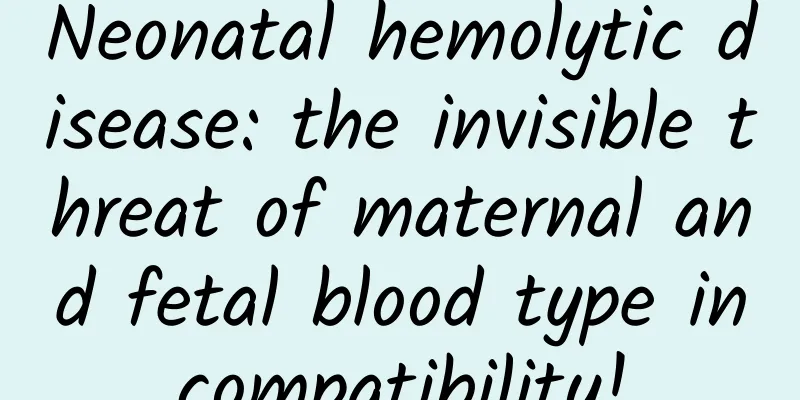Neonatal hemolytic disease: the invisible threat of maternal and fetal blood type incompatibility!

|
Author: Zhong Yan, Chief Physician, Beijing Children's Hospital, Capital Medical University Reviewer: Meihua Park, Chief Physician, Peking University Third Hospital Hemolytic disease of the newborn, as an isoimmune hemolytic disease caused by maternal-fetal blood type incompatibility, is one of the important causes of early neonatal jaundice. Its clinical manifestations are diverse, ranging from mild jaundice to severe anemia, fetal edema and even bilirubin encephalopathy, posing a threat to the health of newborns that cannot be ignored. Hemolytic disease of the newborn is mainly caused by incompatibility of blood types between mother and baby, especially the mismatch between the ABO blood type system and the Rh blood type system. Among the 26 blood type systems that have been discovered, the ABO and Rh blood type systems are particularly critical due to their universality. According to statistics, ABO blood type incompatibility hemolytic disease accounts for about 85% of hemolytic disease of the newborn, while Rh blood type incompatibility hemolytic disease accounts for about 14%. In addition, other rare blood type systems such as the MN blood type system may also cause hemolytic disease, but the incidence is extremely low. For the ABO blood group system, when the mother is type O blood and the father is type A, B or AB blood, the risk of hemolysis in the newborn increases significantly. This is because the mother with type O blood may contain antibodies against A or B antigens, which may enter the fetus through the placenta during pregnancy or delivery, triggering an immune response, leading to red blood cell destruction and hemolysis. The Rh blood type system is more complex, including multiple antigens such as D, C, E, c, and e. Rh positive means that the individual's blood type antigen contains D antigen, while Rh negative does not. When an Rh-negative mother gives birth to an Rh-positive father, if the fetus is Rh-positive, Rh hemolytic disease may occur. It is worth noting that even if both parents are Rh-positive, if the mother lacks certain Rh antigens carried by the fetus (such as E antigen), hemolysis may also occur. Symptoms of neonatal hemolytic disease vary in severity, depending on the degree of hemolysis, the degree of sensitization of fetal red blood cells, and the fetal compensatory ability. Mild hemolysis may only manifest as jaundice, while severe hemolysis may be accompanied by severe symptoms such as anemia, fetal edema, hepatosplenomegaly, bleeding tendency, and even bilirubin encephalopathy. Figure 1 Original copyright image, no permission to reprint Jaundice is one of the most common clinical manifestations of neonatal hemolytic disease, which is characterized by early onset (usually within 24 hours after birth), rapid rise and high jaundice values. Compared with physiological jaundice, hemolytic jaundice is more severe and does not easily disappear on its own. In addition, the severity of anemia is also directly related to the degree of hemolysis. Severe anemia may lead to life-threatening complications such as heart failure and dyspnea. Bilirubin encephalopathy is one of the most serious complications of hemolytic disease, and it often occurs in children with particularly severe hemolysis and extremely high bilirubin levels. Its clinical manifestations can be divided into warning period, spasm period, recovery period and sequelae period. Children in the warning period may experience non-specific symptoms such as weak sucking and weakened response; if not treated in time, they may enter the spasm period and experience serious symptoms such as changes in muscle tone and convulsions; eventually, they may be left with sequelae such as athetosis, hearing impairment, eye movement disorders and enamel hypoplasia. Diagnosis of hemolytic disease of the newborn requires comprehensive clinical manifestations, blood typing, bilirubin and hemoglobin level determination, and anti-human globulin test (Coomb's test) results. In particular, the anti-human globulin test can directly detect whether red blood cells are sensitized and is a key means of diagnosing hemolytic disease. Figure 2 Original copyright image, no permission to reprint The key to preventing hemolytic disease of the newborn lies in early identification and intervention. For pregnant women at risk of hemolytic disease, blood typing and antibody screening should be performed during pregnancy so that timely detection and measures can be taken. For Rh-negative pregnant women, if their husbands are Rh-positive and the titer of anti-RhD antibodies in the pregnant woman (mother) is monitored to be relatively high, anti-RhD immunoglobulin can be infused to the pregnant woman (mother) during pregnancy to reduce the risk of hemolytic disease of the newborn. For children diagnosed with neonatal hemolytic disease, appropriate treatment measures should be taken according to the severity of the disease. Children with mild hemolysis may only need close observation and supportive treatment; while children with severe hemolysis need timely exchange transfusion therapy to reduce bilirubin levels and prevent the occurrence of bilirubin encephalopathy. In addition, phototherapy is also one of the important means of treating hemolytic jaundice. By irradiating the skin with light of a specific wavelength, unconjugated bilirubin is converted into water-soluble isomers and excreted from the body. |
>>: Do not underestimate nasal congestion and hyposmia: Clinical warning of occult nasal tumors
Recommend
Causes of pain on both sides of the waist in women
Women's bodies are much more fragile and sens...
What does a purple sweet potato look like when it's bad? Is it ok to eat a purple sweet potato with white spots inside?
Purple sweet potatoes are the same as the sweet p...
Introduction to Benign Breast Tumors
Breast disease has now become a serious threat to...
Endometriosis Infertility
If a woman suffers from infertility, it will caus...
If you have pets at home, be alert to tinea capitis!
Author: Li Ruoyu, Chief Physician, Peking Univers...
Why am I infertile when my menstrual period is normal?
Many female friends may often suffer from inferti...
Top 5 female private parts cancer rates
Various gynecological diseases have become common...
Can I have abortion at 32 days of pregnancy?
Nowadays, many couples want to live a life togeth...
Is bilateral ovarian cysts serious?
Ovarian cyst is a common cyst disease, which incl...
How to treat a hard caesarean section incision
Many women choose to have a cesarean section, but...
Back-to-school eye protection guide: a few simple steps to make your vision clearer
Children, the new semester has begun. Don’t forge...
What should women eat when they reach menopause?
After reaching menopause, female friends will bec...
What to do if the breast duct is blocked while breastfeeding
When mothers are breastfeeding, the mammary gland...
What to do if you have blocked fallopian tubes
Fallopian tube obstruction is a very common disea...
What are the treatments for uterine prolapse?
Uterine prolapse is also called uterine prolapse....









